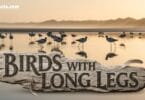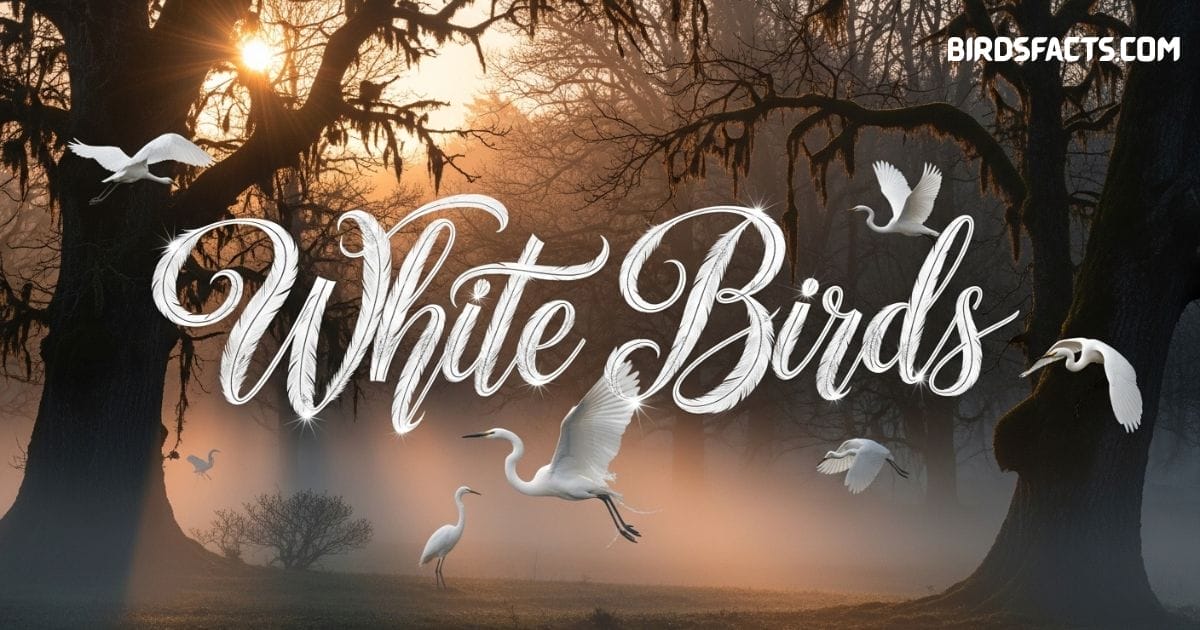
Unexpected White Birds You Can See in Your Backyard
Have You Ever Been Outside Looked Up At The Sky And Spotted A Grace Ful Shape Gliding Across The Water Or Perching Quietly On A Tree? I’ve Often Found Myself Wondering About Those Beautiful White Birds Curious About What Makes Them So Striking Compared To Others. Some Times It Feels Frustrating Not Knowing Their Names Especially When You See Them Almost Everywhere In Florida At The Beach Near Lakes Or Even Walking Through Your Backyard. There’s Something Calming About Their Pure Bright Feathers Yet Also A Sense Of Mystery That Makes You Want To Learn More.
Florida Is One Of The Best Places In The U.s. To See White Birds Thanks To Its Warm Climate Wetlands And Endless Coastline. From The Tall And Elegant Great Egret To The Smaller But Energetic Snowy Egret Each Bird Has Its Own Charm And Role In The Ecosystem. In This Guide We’ll Explore The Most Common White Birds You Might Spot In Florida What Makes Them Unique And The Best Places To See Them In The Wild.
White Birds
- American White Pelican
- Cattle Egret
- Eurasian Spoonbill
- Great Egret
- Great White Heron
- Little Egret
- Mute Swan
- Northern Gannet (adult)
- Red-Billed Tropicbird
- Ross’s Goose
- Royal Spoonbill
- Royal Tern
- Sandwich Tern
- Seagull
- Snow Goose
- Snowy Egret
- Snowy Owl
- Trumpeter Swan
- White Cockatoo
- White Ibis
- White Tern
- Whooping Crane
- Wood Stork
American White Pelican
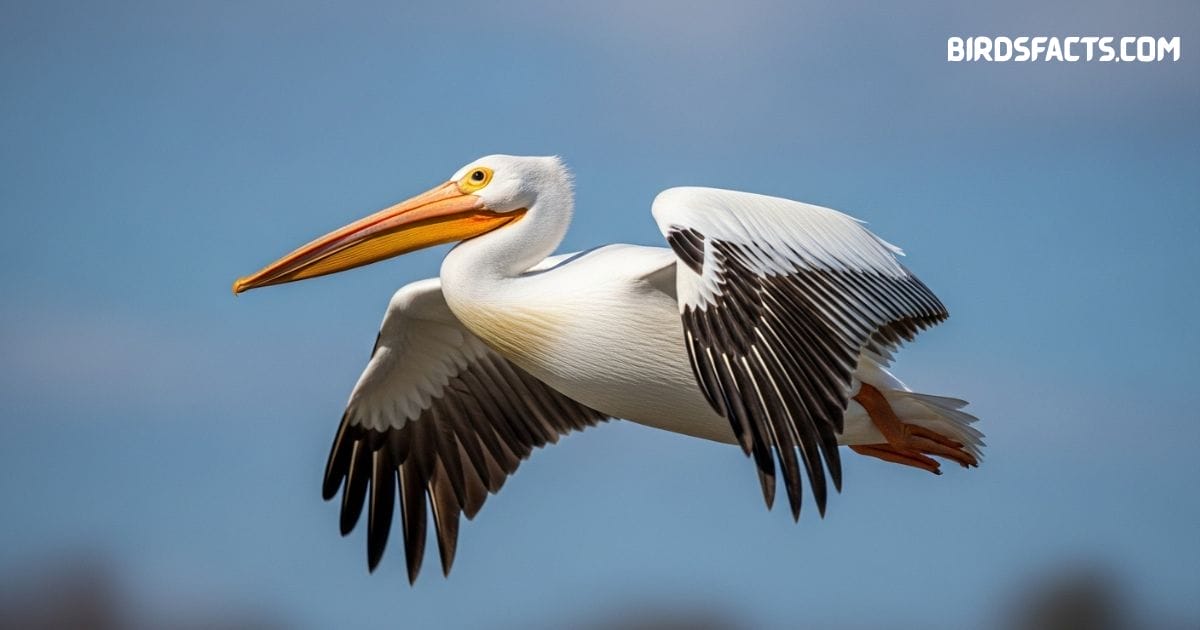
American white pelican gliding over water with large wings and bright orange bill
The American White Pelican (pelecanus Erythrorhynchos) Is Among The Largest White Birds In North America. Unlike The Brown Pelican You May See Diving At The Beach This Species Prefers Freshwater Lakes Marshes And Coastal Lagoons. It Doesn’t Plunge For Food But Instead Works In Cooperative Flocks Herding Fish Into Shallow Water Before Scooping Them Up With Its Enormous Pouch. In Florida They’re Often Winter Visitors Making A Spectacle Of Themselves In The Everglades Or Along The Gulf Coast.
Watching These Birds Feed Is Like Observing A Choreographed Performance. Dozens Of Them Swim In Unison Pushing Fish Toward The Center And Then Dipping Their Bills In Almost Perfect Rhythm. Their Wingspan Can Reach Over Nine Feet Making Them Breathtaking When They Soar Overhead. Despite Their Size They’re Surprisingly Graceful And Their Silent Teamwork Is A Reminder Of How Different Bird Species Have Evolved Unique Survival Strategies.
| Facts | Detail |
|---|---|
| Range | Lakes Marshes And Coastal Waters |
| Key Fact | Large White Waterbird With Black Wing Tips |
| Plumage | Bright White Body With Contrasting Black Wing Feathers |
| Behavior | Feeds By Scooping Fish With Its Big Pouch |
Cattle Egret

Cattle egret standing in grassy field with white feathers and yellow bill
The Cattle Egret (bubulcus Ibis) Is A Smaller But Equally Fascinating Species. Unlike Many Wetland Hunters These Egrets Are Often Spotted Following Livestock Or Tractors In Fields. Their Feeding Style Is Opportunistic They Snatch Insects Disturbed By Moving Animals Or Machines. In Florida’s Farmlands They’re A Common Sight Especially In Spring And Summer When Breeding Season Highlights Their Orange Patches On The Head And Chest.
What Makes Them Memorable Is Their Adapt Ability. Originally From Africa They Spread Rapidly Across The Americas And Became One Of The Most Familiar Farmland Birds. In Backyards They May Wander Through Open Lawns Appearing Bold And Curious Their Ability To Thrive Near Humans Sets Them Apart From Other Egrets And Their Social Flocks Often Create A Lively Atmosphere As They Chatter And Move From Pasture To Pasture.
| Facts | Detail |
|---|---|
| Range | Often Seen Near Cattle In Fields And Grasslands |
| Key Fact | Small White Heron Frequently Found With Grazing Animals |
| Plumage | White Plumage Orange Plumes During Breeding Season |
| Behavior | Eats Insects Stirred Up By Grazing Animals |
Eurasian Spoonbill

Eurasian spoonbill wading in shallow water with long spoon-shaped bill and white plumage
The Eurasian Spoonbill (platalea Leucorodia) Is Another Elegant Addition To The Family Of White Birds Though Far Less Common In North America. With Its Distinct Spoon-shaped Bill This Species Feeds By Sweeping Its Beak Side To Side Through Shallow Water Catching Small Fish And Aquatic Invertebrates. While Rare In Florida Spoonbills Are Well Known In Europe Asia And Parts Of Africa Where They Form Striking Nesting Colonies In Marshlands.
Their Feeding Technique Sets Them Apart From Other Wading Birds Like Herons Or Ibises. Instead Of Waiting Motionlessly To Strike Spoonbills Are Constantly In Motion Probing The Water. During Breeding They Grow Long Crest Plumes And Display Intricate Courtship Rituals. Seeing One In Florida Is Considered Special Often Thrilling Birdwatchers At Places Like Merritt Island National Wildlife Refuge Where Occasional Sightings Have Been Recorded.
| Facts | Detail |
|---|---|
| Range | Wetlands And Shallow Lakes Across Europe / Asia / Africa |
| Key Fact | White Wading Bird With Spoon-Shaped Bill |
| Plumage | White Plumage With Long Legs And Distinctive Spoon-Like Bill |
| Behavior | Sweeps Bill Side To Side To Catch Fish |
Great Egret
The Great Egret (ardea Alba) Is One Of The Most Iconic White Birds You Can Encounter In Florida And Across Much Of The World. With Its Tall Stature Long S Shaped Neck And Dagger Like Bill It’s Often Mistaken For Other Herons. What Makes It Stand Out Especially During Breeding Season Are Its Long Delicate Plumes That Cascade Elegantly Down Its Back. These Feathers Were Once Highly Sought After In The Feather Trade Nearly Driving The Species To Extinction.
Thankfully Strong Conservation Measures Helped The Great Egret Rebound And Today They’re A Common Sight In Wetlands Estuaries And Backyard Ponds. They Hunt Patiently Standing Motionless Before Striking With Lightning Speed To Catch Fish Or Frogs. If You Visit Everglades National Park Or Corkscrew Swamp Sanctuary You’ll Almost Certainly See These Regal Hunters Often Perched Like Statues Waiting For The Perfect Moment To Strike.
| Facts | Detail |
|---|---|
| Range | Common In Marshes / Swamps / Rivers |
| Key Fact | Tall Elegant White Heron |
| Plumage | White Plumage With Yellow Bill And Long Black Legs |
| Behavior | Wades Slowly Through Water To Hunt Fish Frogs And Insects |
Great White Heron
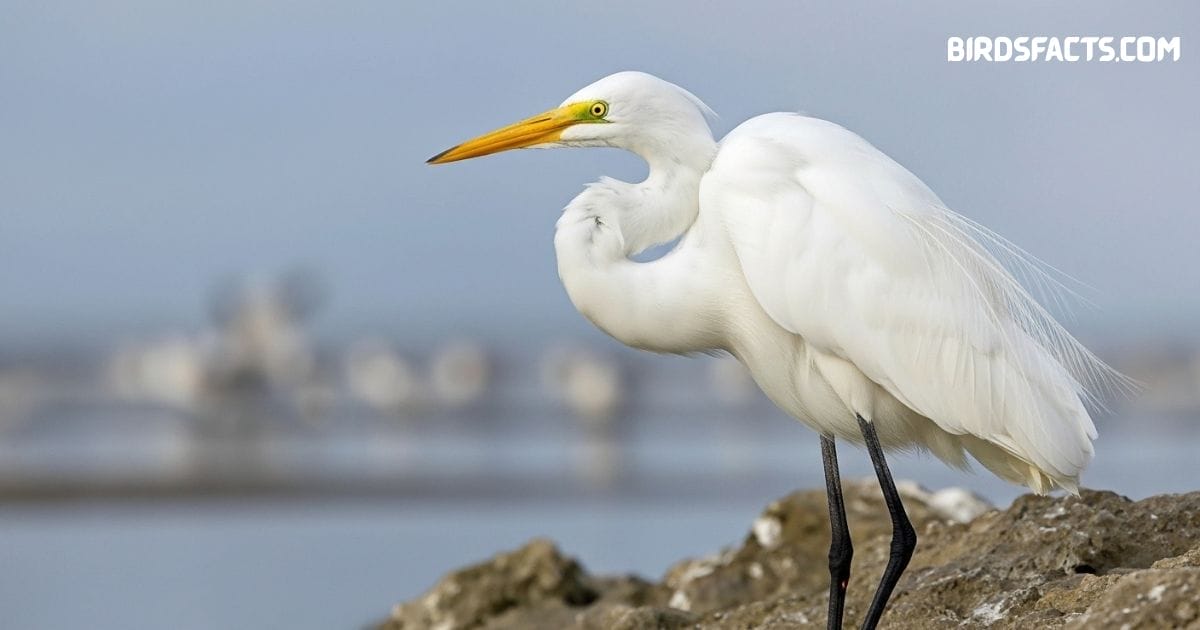
Great egret standing in wetlands with long neck, white plumage, and yellow bill
The Great White Heron Is Essentially A White Morph Of The Great Blue Heron Found Primarily In Southern Florida And The Florida Keys. Unlike The Great Egret It Has A Heavier Build A Larger Bill And A More Imposing Presence. Birdwatchers Often Debate Whether It Should Be Classified As A Separate Species But Either Way Its Rarity And Limited Range Make It An Exciting Find.
These White Birds Are Masters Of Stealth. They Wade Slowly Through Coastal Mangroves And Shallow Flats Blending Into Their Surroundings Despite Their Bright Plumage. Their Primary Diet Is Fish But They’re Also Known To Eat Crustaceans And Amphibians. If You’re Lucky Enough To Spot One While Bird Watching In Florida It Will Likely Be Near Saltwater Habitats Standing Silently Until It Lunges Forward With An Impressive Strike.
| Facts | Detail |
|---|---|
| Range | Found Mainly In Florida / The Caribbean |
| Key Fact | White Form Of The Great Blue Heron |
| Plumage | All White Plumage Larger And Heavier Than The Great Egret |
| Behavior | Hunts Fish Amphibians And Crustaceans In Shallow Coastal Waters |
Little Egret

Little egret wading in shallow water with slender black bill and white plumage
The Little Egret (egretta Garzetta) Is More Commonly Found In Europe Asia And Africa But Rare Sightings Occur In Florida Making Them Special Among Birdwatchers. Slightly Smaller Than The Snowy Egret It Has Slim Black Legs With Yellow Feet A Sharp Black Bill And A Graceful Delicate Appearance.
Although Not Native To North America These White Birds Occasionally Wander Across The Atlantic Showing Up In Unexpected Coastal Locations. Their Hunting Style Mirrors That Of Their Close Relatives: Active Darting Movements Combined With Quick Dashes To Grab Prey. In Areas Where They’re More Common Like Wetlands In Europe They Often Feed In Flocks Creating A Dazzling Scene Of White Wings Fluttering Above The Water. A Glimpse Of One In Florida Is Enough To Cause Excitement In The Bird Watching Community.
| Facts | Detail |
|---|---|
| Range | Common In Europe / Africa / Asia |
| Key Fact | Slim White Heron With Black Legs And Yellow Feet |
| Plumage | White Plumage With Slender Body And Distinctive Yellow Feet |
| Behavior | Hunts Small Fish In Shallow Water |
Mute Swan
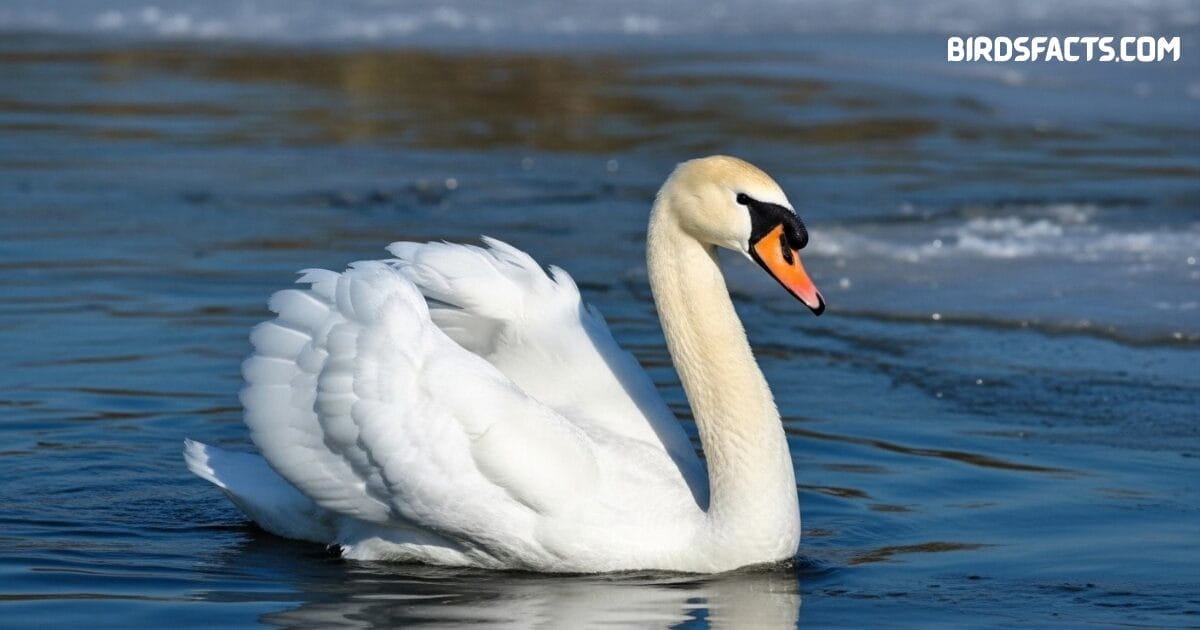
Mute swan gracefully swimming on calm water with white plumage and orange bill
The Mute Swan (cygnus Olor) Is One Of The Most Recognizable Swans Worldwide. Known For Its Long Elegant Neck And Orange Bill With A Black Knob It Often Graces Ponds Lakes And Rivers In Parks And Estates. Although Not Native To North America They Were Introduced From Europe And Are Now Found In Several Regions Including Parts Of The United States.
These White Birds Are Often Associated With Beauty Romance And Even Fairy Tales. However They’re Also Fiercely Territorial Especially During Nesting Season. Watching A Pair Glide Across A Lake Can Be Mesmerizing But Anyone Who Gets Too Close To Their Cygnets May Be Met With Aggressive Wing-flapping And Hissing. Despite Their Sometimes Aggressive Nature Their Grace On The Water Makes Them One Of The Most Admired Waterfowl Species.
| Facts | Detail |
|---|---|
| Range | Native To Europe / Introduced Worldwide |
| Key Fact | Large White Swan With Orange Bill |
| Plumage | White Plumage With Long Neck And Elegant Appearance |
| Behavior | Graceful Bird Often Seen On Lakes And Ponds |
Northern Gannet
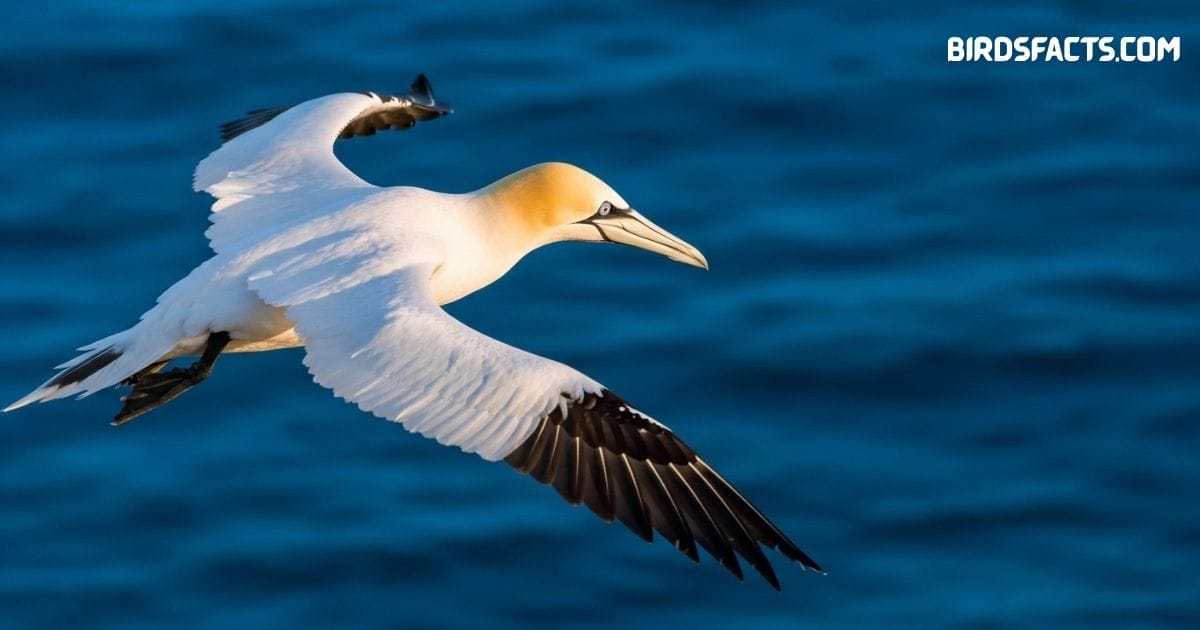
VNorthern gannet soaring over ocean with white body, black wingtips, and yellow head
The Northern Gannet (morus Bassanus) Is A Striking Seabird Mostly White With Black Wing Tips And A Yellowish Head. Adults Are Known For Their Dramatic Plunge Diving Style Folding Their Wings And Spearing Into The Water From Heights Of Up To 100 Feet. While More Common Along The North Atlantic They Occasionally Appear Off Florida’s Coast During Migration.
These White Birds Are Built For The Ocean. With Streamlined Bodies And Sharp Eyesight They Can Spot Fish From Great Distances. Their Colonies Are Massive Often Covering Rocky Cliffs In Places Like Newfoundland Or Scotland. When They Appear In Florida Waters It’s A Special Event For Birdwatchers Who Usually Only See Them While Traveling Further North. Their Aerial Dives Like Arrows Piercing The Sea Leave A Lasting Impression On Anyone Lucky Enough To Witness Them.
| Facts | Detail |
|---|---|
| Range | Found Along Atlantic Coasts |
| Key Fact | White Seabird With Yellowish Head |
| Plumage | White Plumage With Black Wing Tips And Yellowish Head |
| Behavior | Dives From Height Into Ocean To Catch Fish |
Red-Billed Tropicbird
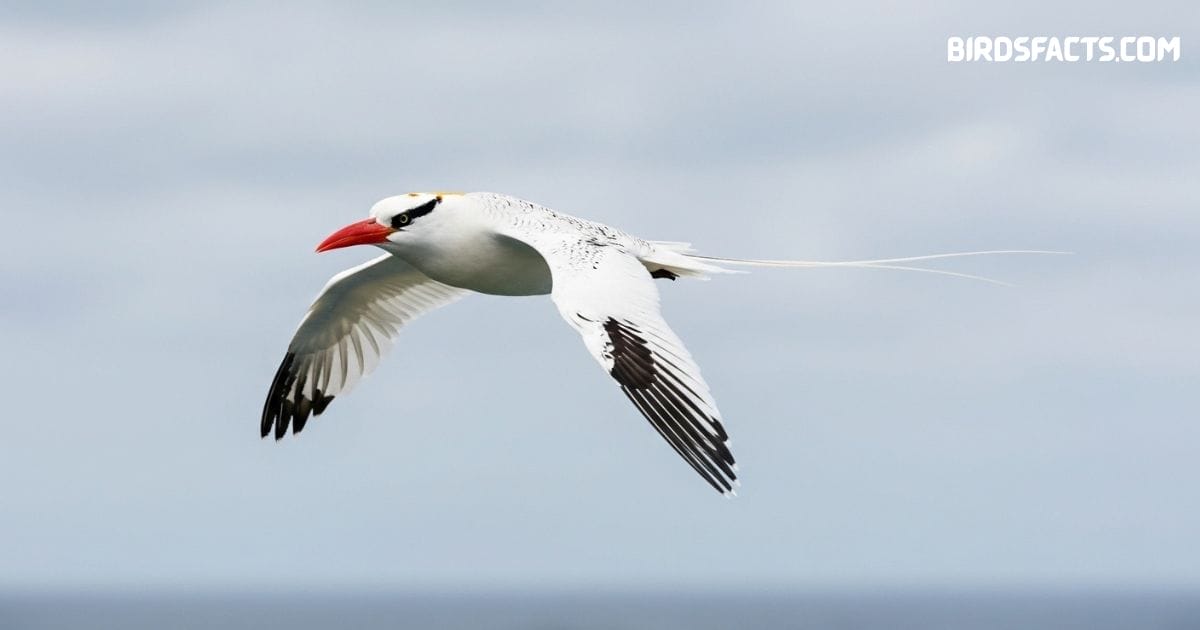
Red-billed tropicbird flying over ocean with long tail streamers and bright red bill
The Red-billed Tropicbird (phaethon Aethereus) Is A Grace Ful Seabird Often Seen Gliding Effort Lessly Over Tropical Waters. Its Bright Red Bill Long Tail Streamers And Mostly White Plumage Make It Instantly Recognizable. While More Common In The Caribbean And Pacific It’s Sometimes Spotted Near Florida’s Offshore Islands Or Coastal Waters.
These White Birds Spend Most Of Their Lives At Sea Only Returning To Land To Nest On Rocky Cliffs. Their Aerial Maneuvers Are Breathtaking Soaring With Long Wings Stretched Out As They Follow The Trade Winds. Because They Nest In Hard-to-reach Places Seeing One Is A Rare Privilege. For Florida Birdwatchers A Glimpse Of A Red-billed Tropicbird Feels Almost Like Encountering A Visitor From Another World Drifting Gracefully Between Sky And Ocean.
| Facts | Detail |
|---|---|
| Range | Found In Tropical Oceans |
| Key Fact | Mostly White With Long Tail Streamers |
| Plumage | White Plumage With Bright Red Bill And Black Markings |
| Behavior | Strong Flier Often Seen Gliding Over Open Sea |
Ross’s Goose

Ross’s goose standing in grassy field with white plumage and short pink bill
Ross’s Goose (anser Rossii) Is A Smaller Cousin Of The Snow Goose With Pure White Plumage Short Stubby Bill And Dark Wingtips. While More Common In The Arctic And Central North America Flocks Occasionally Migrate Through Florida During The Winter Months Their Compact Size And Sociable Nature Make Them Easy To Distinguish From Larger Geese.
These White Birds Are Typically Seen In Large Flocks Sometimes Mixed With Snow Geese. Their Loud Honking Calls Echo Across Open Fields And Wetlands Especially During Migration. Unlike Solitary Hunters Such As Egrets Or Herons Geese Depend On Their Numbers For Safety And Navigation. Spotting A Group Of Ross’s Geese Flying In Perfect V Formation Across The Sky Is A Beautiful Reminder Of The Instinctive Patterns That Guide Migratory Birds Every Year.
| Facts | Detail |
|---|---|
| Range | Migrates Across North America |
| Key Fact | Small Compact White Goose |
| Plumage | White Plumage With Short Stubby Bill And Blue Base |
| Behavior | Travels In Large Migratory Flocks Often With Snow Geese |
Royal Spoonbill
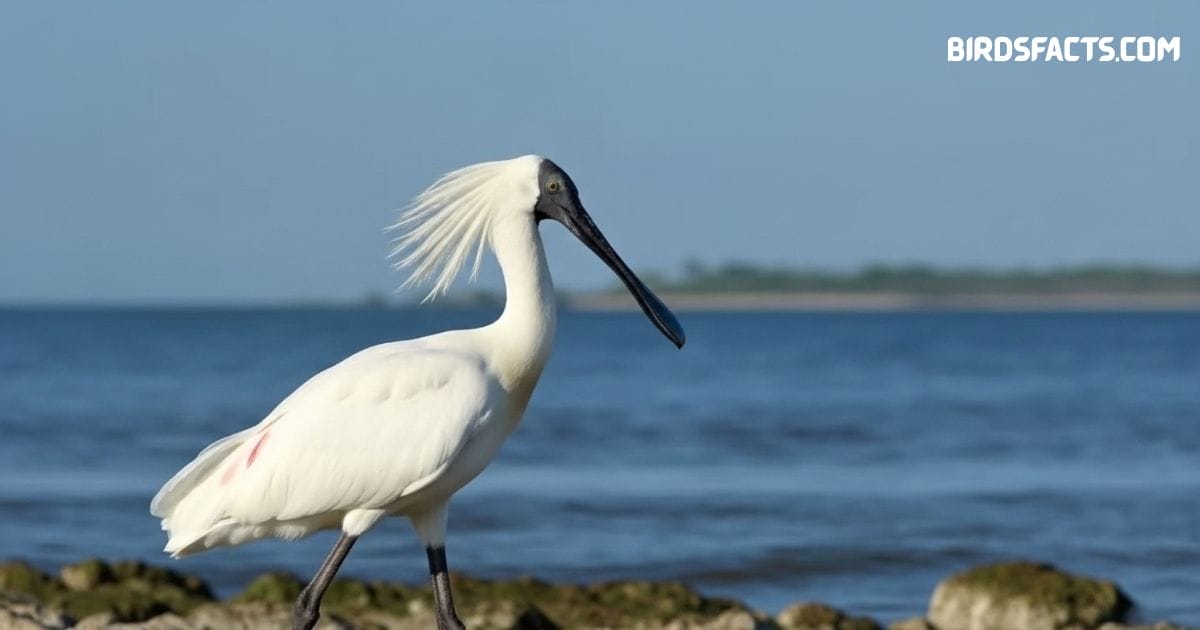
Royal spoonbill wading in shallow water with white plumage and long spoon-shaped bill
The Royal Spoonbill (platalea Regia) Is Primarily Found In Australia And New Zealand But It Shares The Same Family As The Eurasian Spoonbill. With A Spoon-shaped Bill And Pure White Plumage It’s A Standout Among Wading Birds. Though Not Native To Florida Bird Enthusiasts Sometimes Draw Comparisons Between This Species And Other Spoonbills Occasionally Sighted In The State.
Like Other Spoonbills These White Birds Forage By Sweeping Their Bills Side To Side Through Shallow Waters Their Feeding Behavior Is Mesmerizing To Watch As The Rhythmic Motion Seems Both Deliberate And Graceful. During Breeding Season Royal Spoonbills Grow Long White Plumes On Their Heads Making Them Look Even More Striking Even If You Don’t Spot This Exact Species In Florida Knowing About Its Relatives Deepens Your Appreciation For The Variety Within The Spoonbill Family.
| Facts | Detail |
|---|---|
| Range | Found In Australia / New Zealand / Asia |
| Key Fact | White Bird With Spoon-Shaped Black Bill |
| Plumage | White Plumage With Distinctive Crest During Breeding Season |
| Behavior | Breeds In Colonies Near Wetlands |
Royal Tern
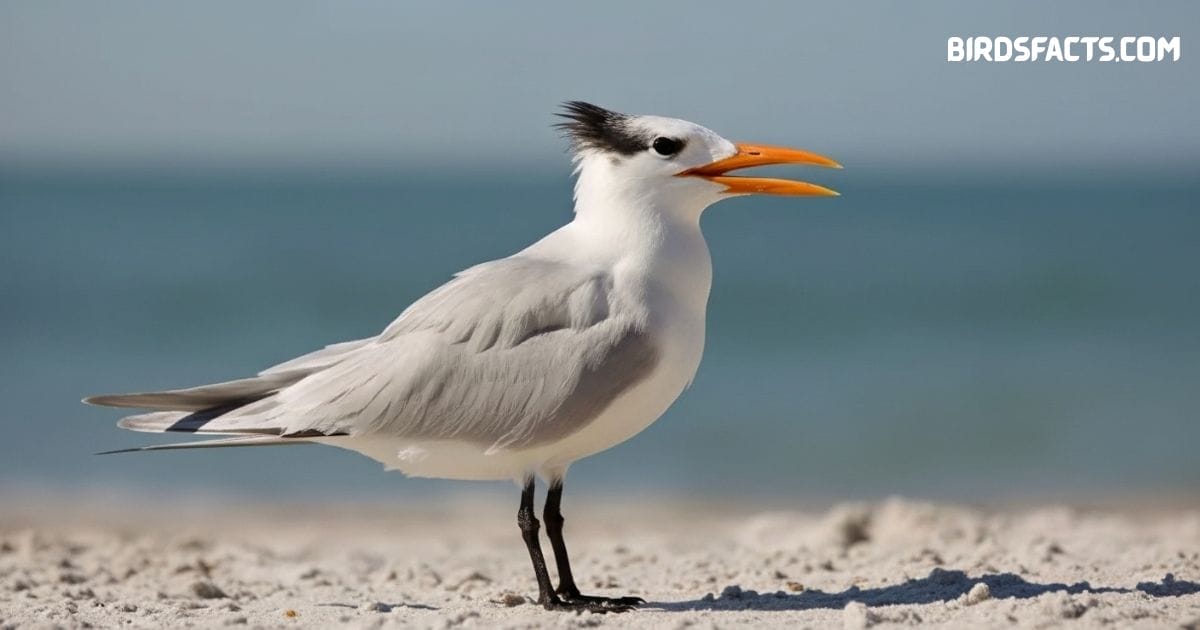
Royal tern perched near shoreline with sleek white plumage, black cap, and bright orange bill
The Royal Tern (thalasseus Maximus) Is One Of The Most Common Seabirds Along Florida’s Coastlines. With Its Sleek Body Orange Bill And Elegant Flight It’s Easy To Recognize As It Patrols Beaches And Dives Into The Surf For Fish. Colonies Often Gather By The Hundreds Filling Sandy Stretches Of Shoreline With Noise And Energy.
These White Birds Thrive In Social Groups Nesting In Dense Colonies On Barrier Islands And Sandbars. Their Loud Calls And Constant Movement Give Life To Florida’s Coastal Habitats. Watching Them Plunge Into The Water Is A Treat As They Hover Briefly Before Folding Their Wings And Darting Downward. For Beachgoers They’re A Familiar Companion And For Birdwatchers They’re A Reminder Of The Thriving Life Along The State’s Shores.
| Facts | Detail |
|---|---|
| Range | Nests In Colonies On Sandy Beaches |
| Key Fact | White Seabird With Black Crest |
| Plumage | White Plumage With Bright Orange Bill And Long Pointed Wings |
| Behavior | Social Seabird Often Diving For Fish Near Shorelines |
Sandwich Tern
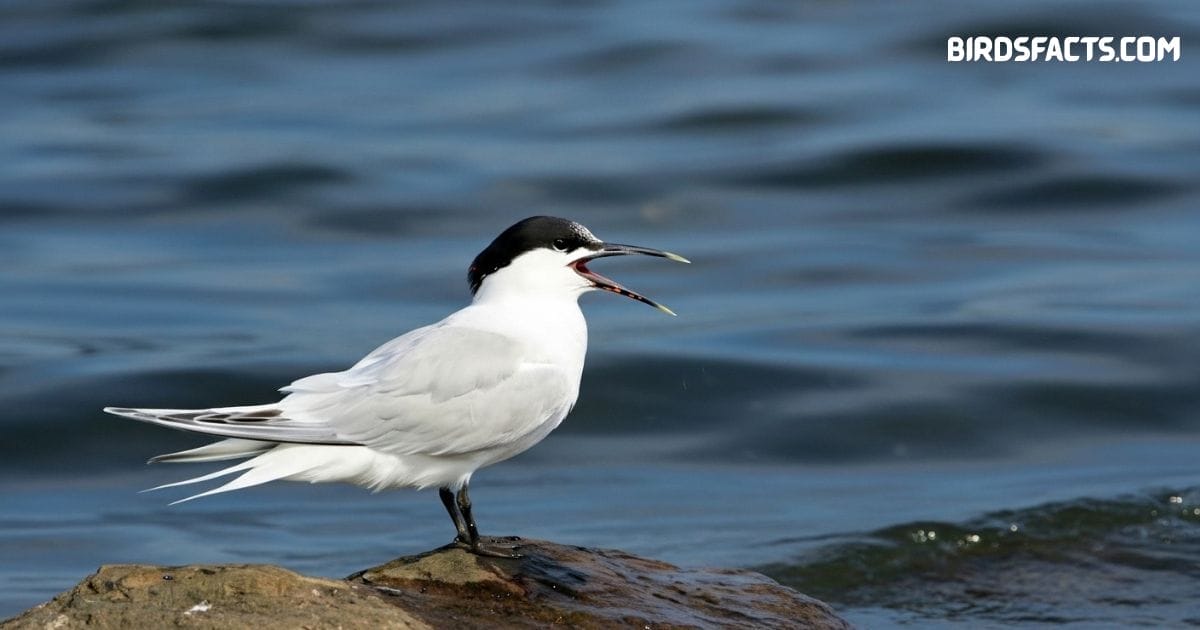
Sandwich tern standing on sandy shore with white body, black cap, and yellow-tipped bill
The Sandwich Tern (thalasseus Sandvicensis) Is Another Elegant Seabird Often Seen Along Florida’s Shores. Recogniz Able By Its Sharp Black Bill Tipped With Yellow It Has A Slightly Slimmer Profile Than The Royal Tern. These Birds Prefer Sandy Beaches And Offshore Islands Where They Form Dense Nesting Colonies During The Breeding Season.
These White Birds Are Remark Able Divers Plunging Into The Ocean To Snatch Small Fish With Pinpoint Accuracy. They Often Feed In Groups And Their Calls Carry Across The Beach Adding To The Lively Atmosphere Of The Coastline Bird Watchers Can Often Spot Them At Fort De Soto Park Or Merritt Island Where Their Colonies Create An Impressive Display Of Synchronized Flight And Group Nesting Behavior.
| Facts | Detail |
|---|---|
| Range | Common Along Coasts And Estuaries |
| Key Fact | Medium-Sized White Tern With Black Cap |
| Plumage | White Plumage With Slender Black Bill Tipped With Yellow |
| Behavior | Nests In Colonies And Dives Gracefully To Catch Fish |
Seagull

Seagull standing on rocky shore with white body, gray wings, and yellow bill
Seagulls Are Some Of The Most Familiar Coastal Birds With Several Species Found Along Florida’s Beaches. While Not Entirely White Many Gulls Such As The Ring-billed Gull Or The Laughing Gull In Nonbreeding Plumage Appear Mostly White With Gray Wings. They’re Opportunistic Feeders Thriving Around Fishing Docks Beaches And Even Urban Areas Where Food Is Abundant.
These White Birds Are Clever And Adaptable. They’ve Been Seen Stealing Food From Other Birds Snatching Fries From Beachgoers And Scavenging Along Piers Their Loud Calls And Confident Behavior Make Them Hard To Ignore. Despite Being Common Gulls Are Important To The Ecosystem Cleaning Up Waste And Signaling Changes In Fish Populations. Watching Their Flight Patterns Over Waves Can Be Both Calming And Fascinating.
| Facts | Detail |
|---|---|
| Range | Found Worldwide Along Coasts And Cities |
| Key Fact | Mostly White Seabirds With Gray Wings |
| Plumage | White Plumage With Gray Wings And Black Wing Tips In Some Species |
| Behavior | Scavengers That Eat Fish Scraps And Insects |
Snow Goose
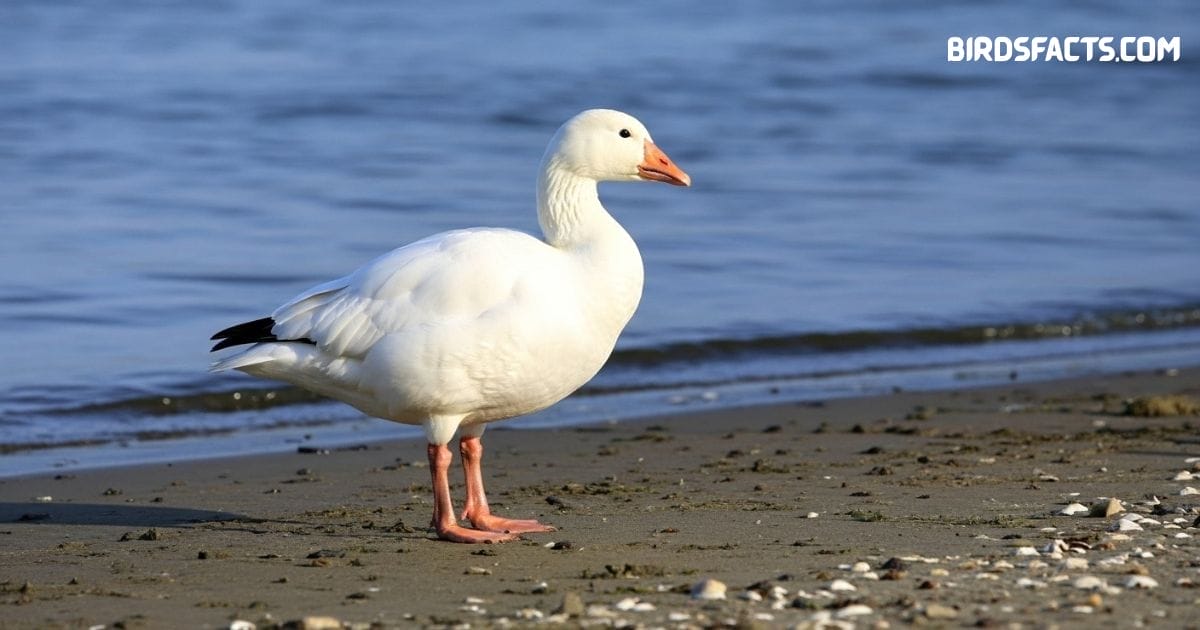
Snow goose standing in open field with white plumage and black wingtips
The Snow Goose (anser Caerulescens) Is A Migratory Species That Occasionally Passes Through Florida During Winter. With Pure White Plumage And Black Wingtips They’re Stunning In Flight Especially When Traveling In Massive Flocks That Stretch Across The Sky Their Loud High Pitched Calls Are Often Heard Before The Birds Themselves Are Seen.
These White Birds Migrate Thousands Of Miles Between Arctic Breeding Grounds And Southern Wintering Areas Their Synchronized Movements Create Beautiful Aerial Displays Resembling Shifting Clouds Against The Sky. While More Common Further North Flocks Sometimes Rest In Florida Wetlands And Fields Providing A Spectacular Sight For Local Birdwatchers. Their Presence Highlights The Incredible Endurance And Navigation Skills Of Migratory Species.
| Facts | Detail |
|---|---|
| Range | Breeds In Arctic Tundra Regions |
| Key Fact | White Goose With Black Wingtips |
| Plumage | White Plumage With Contrasting Black Wingtips |
| Behavior | Migrates In Large Noisy Flocks Often Seen In V Formations |
Snowy Egret
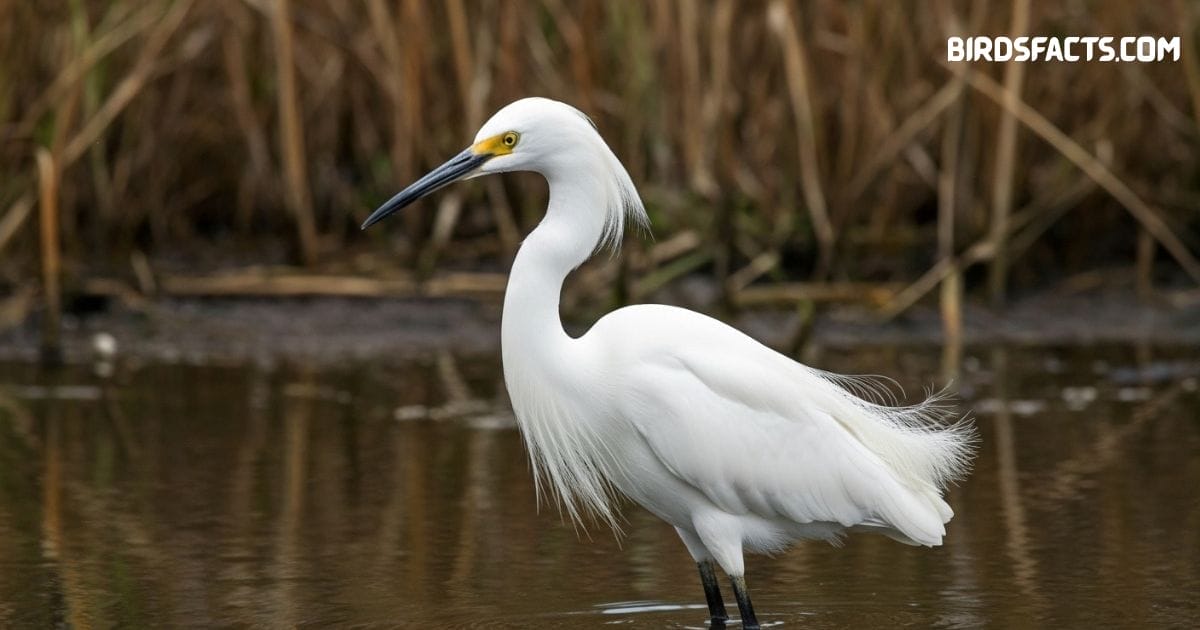
Snowy egret wading in shallow water with white plumage black legs and yellow feet
The Snowy Egret (egretta Thula) Is One Of Florida’s Most Grace Ful Wading Birds. Known For Its Bright Yellow Feet And Elegant White Plumage It’s A Favorite Among Birdwatchers. Unlike The More Patient Great Egret The Snowy Egret Uses An Active Hunting Style Dashing Through Shallow Waters Stirring Up Prey With Its Feet And Striking Quickly.
These White Birds Nearly Disappeared In The Late 19th Century Due To Demand For Their Lacy Plumes In The Fashion Trade. Thank Fully Conservation Laws Brought Their Numbers Back And Today They’re Commonly Seen In Wetlands Estuaries And Coastal Areas. Their Lively Behavior And Striking Appearance Make Them One Of The Most Beloved Bird Species In Florida.
| Facts | Detail |
|---|---|
| Range | Found In Wetlands / Marshes / Coastal Areas |
| Key Fact | Elegant White Heron With Black Legs And Yellow Feet |
| Plumage | White Plumage With Fancy Breeding Plumes |
| Behavior | Hunts Fish And Insects In Shallow Water |
Snowy Owl
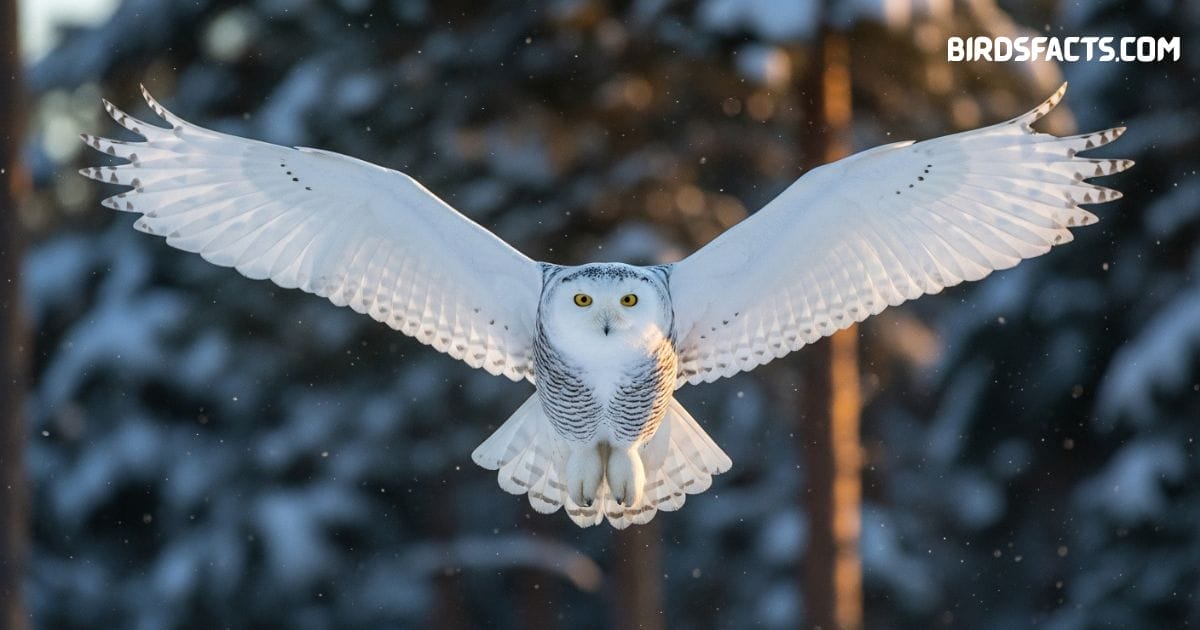
Snowy owl perched on snowy ground with white plumage and dark spotted markings
The Snowy Owl (bubo Scandiacus) Is A Rare And Extraordinary Visitor To Florida Usually Seen Only During Unusual “irruption Years” When Large Numbers Move South From The Arctic. With Mostly White Feathers And Piercing Yellow Eyes They Look Majestic Perched On Dunes Or Open Fields.
These White Birds Are Skilled Hunters Preying On Rodents Birds And Other Small Animals. Unlike Most Owls They’re Active During The Day Making Them Easier To Spot When They Appear Outside Their Normal Range. Seeing A Snowy Owl In Florida Is A Once In A Life Time Experience For Many Birdwatchers Since They Normally Live In The Tundra And Snowy Plains Far To The North. Their Presence Adds A Touch Of Arctic Mystery To The State’s Wildlife Scene.
| Facts | Detail |
|---|---|
| Range | Found In Arctic Tundra / Open Fields |
| Key Fact | Mostly White Owl With Dark Spots |
| Plumage | White Plumage With Dark Markings More On Females Than Males |
| Behavior | Hunts Lemmings And Small Mammals |
Trumpeter Swan
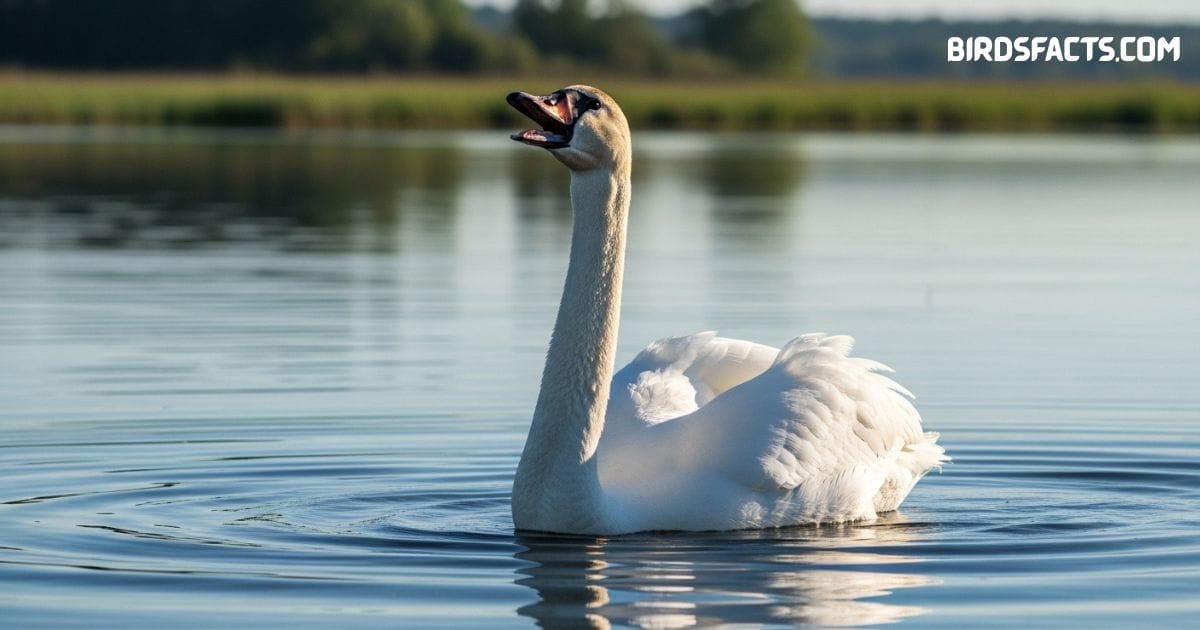
Trumpeter swan swimming gracefully on lake with white plumage and long black bill
The Trumpeter Swan (cygnus Buccinator) Is The Largest Native Waterfowl In North America With An Impressive Wingspan That Can Exceed Eight Feet Its Snowy White Plumage And Deep Resonant Call Make It Unmistak Able. While Not Common In Florida These Swans Have Been Reintroduced In Several Regions Of The U.s. And Rare Sightings Occasionally Occur During Migration.
These White Birds Symbolize Both Strength And Grace. Watching A Pair Glide Across A Lake Is Like Witnessing A Moving Piece Of Art. Despite Their Elegance They’re Also Powerful Defenders Of Their Nesting Territories Chasing Away Intruders With Strong Wingbeats. Their Recovery From Near Extinction Is One Of Conservation’s Great Success Stories Proving How Dedicated Efforts Can Bring Species Back From The Brink.
| Facts | Detail |
|---|---|
| Range | Found In North America Lakes / Rivers / Wetlands |
| Key Fact | North Americas Largest Native Waterfowl |
| Plumage | White Plumage With Long Black Bill |
| Behavior | Known For Deep Trumpet-Like Calls |
White Cockatoo

White cockatoo perched on branch with white plumage and prominent yellow crest
The White Cockatoo (cacatua Alba) Also Called The Umbrella Cockatoo Is Native To Indonesia But Has Become Popular As A Pet Around The World. These Medium Sized Parrots Are Almost Entirely White With A Striking Crest That They Raise When Excited Or Alarmed. While Not Naturally Found In Florida Escaped Or Released Individuals Some Times Adapt To Local Environments.
These White Birds Are Intelligent Social And Known For Their Playful Personalities. In Captivity They Can Mimic Sounds Interact With Humans And Form Deep Bonds With Their Caretakers. In The Wild They Live In Flocks Communicating With Loud Calls And Working Together To Find Food Their Beauty And Charm Make Them Highly Sought After Though They Require Careful Management As Pets Due To Their Long Lifespan And Demanding Nature.
| Facts | Detail |
|---|---|
| Range | Native To Indonesia / Kept Worldwide As Pet |
| Key Fact | Large White Parrot With Distinctive Crest |
| Plumage | White Plumage With Yellow Crest Feathers |
| Behavior | Intelligent Social Bird Known For Loud Calls And Mimicry |
White Ibis

White ibis wading in wetlands with white plumage and long curved red bill
The White Ibis (eudocimus Albus) Is One Of The Most Recogniz Able White Birds In Florida. With Its Long Curved Red Bill And Bright Red Legs It Often Forages In Groups Across Lawns Wetlands And Coastal Areas. In Fact Flocks Of Ibis Walking Casually Through Neighbor Hoods Are A Common Sight In Many Florida Towns.
These Birds Use Their Distinctive Bills To Probe Soft Ground For Insects Crustaceans And Small Fish. They Often Feed In Flocks Creating A Lively Scene As Dozens Move Across Grass Or Shallow Water. During Breeding Season Large Colonies Form In Wetlands Filling The Air With Noise And Activity Their Adapt Ability And Boldness Make Them A Favorite Among Residents And Visitors Alike Embodying .The Every Day Presence Of Wildlife In Florida.
| Facts | Detail |
|---|---|
| Range | Found In Wetlands Of The Americas |
| Key Fact | White Body With Long Curved Red Bill |
| Plumage | White Plumage With Long Legs And Red Facial Skin |
| Behavior | Feeds On Crustaceans And Insects |
White Tern
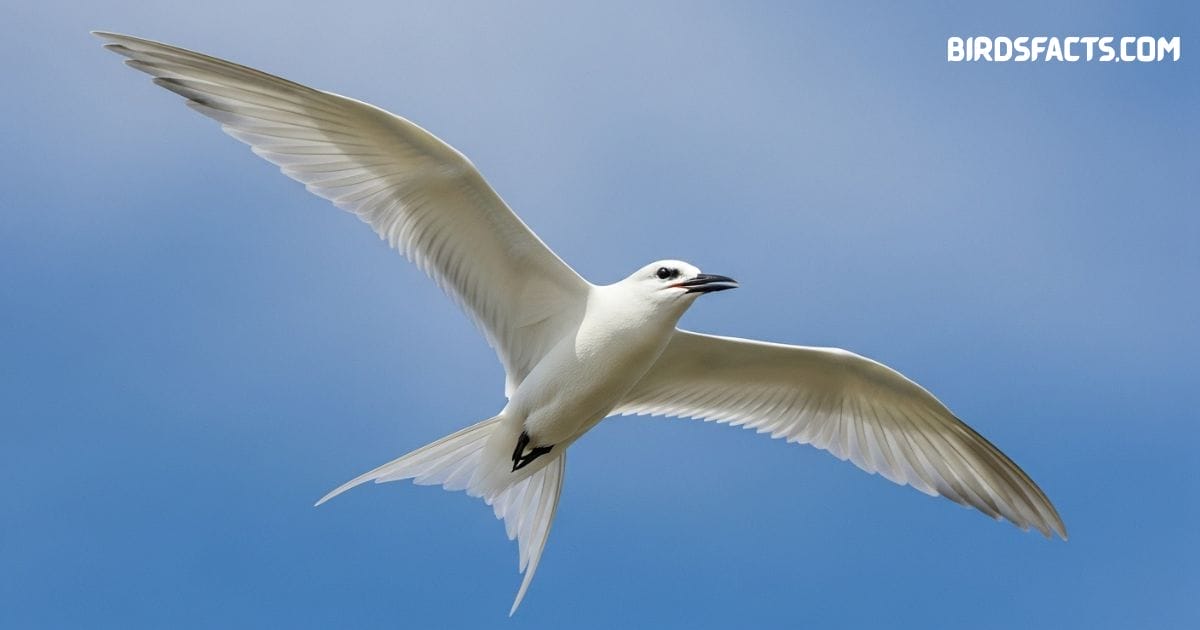
White tern flying over tropical coastline with pure white plumage and slender black bill
The White Tern (gygis Alba) Is A Graceful Seabird Best Known From Tropical Pacific Islands Though It’s Rarely Spotted In Florida. With Pure White Plumage And Dark Eyes It Looks Almost Angelic As It Hovers And Glides Effortlessly Above The Ocean. Unlike Most Seabirds The White Tern Doesn’t Build A Nest It Lays Its Egg Directly On A Tree Branch Or Cliff Ledge.
These White Birds Are Symbols Of Simplicity And Elegance. Their Habit Of Hovering In Place While Searching For Small Fish And Squid Gives Birdwatchers A Perfect View Of Their Delicate Beauty. Although You’re Unlikely To See One In Your Florida Back Yard Their Presence In The Tropics Adds To The Diversity Of White Plumaged Seabirds Around The World.
| Facts | Detail |
|---|---|
| Range | Found On Tropical Islands And Coasts |
| Key Fact | Pure White Seabird With Black Eyes And Bill |
| Plumage | All White Plumage With Slender Body And Long Wings |
| Behavior | Nests By Laying Eggs On Bare Branches |
Whooping Crane

Whooping crane standing in wetland with tall white body, red crown, and black wingtips
The Whooping Crane (grus Americana) Is One Of The Rarest And Most Endangered White Birds In North America. Standing Nearly Five Feet Tall With A Wingspan Of Over Seven Feet It’s An Impressive Sight. Florida Once Hosted Wintering Populations And Conservation Projects Continue To Support Their Migration Routes And Recovery.
These Cranes Are Symbols Of Perseverance Once Reduced To Fewer Than 20 Individuals Their Population Has Slowly Rebounded Thanks To Care Ful Protection And Reintroduction Programs. In Florida They Can Some Times Be Spotted In Marshes And Wildlife Reserves Inspiring Awe Among Bird Watchers Their Haunting Calls And Graceful Flight Serve As Reminders Of The Importance Of Protecting Fragile Species And The Habitats They Depend On.
| Facts | Detail |
|---|---|
| Range | Migrates Between Canada And Texas |
| Key Fact | Tall White Crane With Red Crown |
| Plumage | White Plumage With Black Wingtips And Red Facial Markings |
| Behavior | Critically Endangered Species With Limited Migratory Population |
Wood Stork

Wood stork wading in shallow water with white plumage and dark featherless head
The Wood Stork (mycteria Americana) Is One Of Florida’s Most Distinctive Wading Birds. Unlike Elegant Egrets And Herons It Has A Bald Dark Head Paired With White Plumage Giving It A Somewhat Prehistoric Appearance. These Large Birds Are Found In Wetlands Swamps And Marshes Where They Feed Using A Unique Method Called Tactile Foraging. Instead Of Relying On Sight They Sweep Their Open Bills Through The Water And Snap Shut The Moment They Touch Prey.
These White Birds Were Once Listed As Endangered But Thanks To Strong Conservation Efforts Their Populations Have Shown Signs Of Recovery. They Nest In Colonies High In Cypress Trees Creating Lively Rookeries Filled With Hundreds Of Birds. For Many Visitors To The Everglades And Corkscrew Swamp Sanctuary The Wood Stork Represents A Conservation Success Story And A Reminder Of How Delicate Wetland Ecosystems Are.
| Facts | Detail |
|---|---|
| Range | Native To The Americas Especially Florida |
| Key Fact | Large White Stork With Bald Dark Head |
| Plumage | White Plumage With Black Wing Feathers |
| Behavior | Feeds In Shallow Wetlands By Snapping Fish |
Frequently Asked Questions (FAQs)
What Are The Most Common White Birds In Florida?
The Most Common White Birds In Florida Include The Great Egret Snowy Egret White Ibis Cattle Egret And Wood Stork.
Why Do People Often Spot White Birds In Wetlands?
Wetlands Provide Shallow Waters Filled With Fish Frogs And Insects Making Them Ideal Feeding Grounds For White Birds.
Are All White Birds The Same Species?
No White Birds Come From Many Different Families Including Egrets Pelicans Swans And Gulls Each With Unique Traits.
Do White Birds Migrate Through Florida?
Yes Some White Birds Such As Snow Geese And American White Pelicans Migrate Through Florida During Winter Months.
What Makes White Birds Easy To Recognize?
Their Bright Plumage Stands Out Against Natural Landscapes Making White Birds Easier To Spot Than Darker Or Patterned Species.
Conclusion
From Soaring Pelicans To Back Yard Ibises From Rare Cranes To Elegant Egrets The Variety Of White Birds Across Florida And Beyond Is Truly Remarkable. Each Species Brings Something Different To The Landscape Some Represent Grace And Beauty Others Resilience And Survival. Observing Them Not Only Provides Joy But Also Reveals The Inter Connected Ness Of Ecosystems From Wetlands And Coastlines To Farmlands And Suburban Neighbor Hoods.
As You Explore Your Backyard Local Parks Or Wildlife Refuges Keep An Eye Out For These Striking Birds. Their Presence Adds Color Ironically Through Their Whiteness To The Natural World Around Us. Appreciating Them Also Means Supporting The Conservation Work That Ensures Future Generations Can Continue To Enjoy Their Beauty Whether It’s The Elegance Of A Swan The Curiosity Of An Ibis Or The Rarity Of A Crane White Feathered Birds Are Timeless Symbols Of Nature’s Diversity And Wonder.
Further Reading
You May Also Check Out:
- Small Black Bird with White Belly
- Birds With Orange Beaks
- Big Birds in Ohio
- Florida Birds with Long Beaks
- Woodpeckers Found in North Dakota
- Skynettool Fire Tool
Thank You For Reading!





